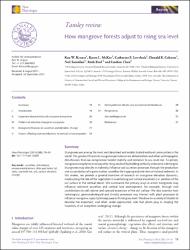Mostrar el registro sencillo del ítem
How mangrove forests adjust to rising sea level
| Autor | Krauss, Ken W. | |
| Autor | McKee, Karen L. | |
| Autor | Lovelock, Catherine E. | |
| Autor | Cahoon, Donald R. | |
| Autor | Saintilan, Neil | |
| Autor | Reef, Ruth | |
| Autor | Chen, Luzhen | |
| Fecha de admisión | 2024-01-04T19:51:31Z | |
| Fecha disponible | 2024-01-04T19:51:31Z | |
| Año | 2014 | |
| Citación | Krauss, K. W., McKee, K. L., Lovelock, C. E., Cahoon, D. R., Saintilan, N., Reef, R., & Chen, L. (2014). How mangrove forests adjust to rising sea level. New Phytologist, 202(1), 19-34. Recuperado de: | es |
| URI | https://bvearmb.do/handle/123456789/3837 | |
| Sinopsis | Mangroves are among the most well described and widely studied wetland communities in the world. The greatest threats to mangrove persistence are deforestation and other anthropogenic disturbances that can compromise habitat stability and resilience to sea-level rise. To persist, mangrove ecosystems must adjust to rising sea level by building vertically or become submerged. Mangroves may directly or indirectly influence soil accretion processes through the production and accumulation of organic matter, as well as the trapping and retention of mineral sediment. In this review, we provide a general overview of research on mangrove elevation dynamics, emphasizing the role of the vegetation in maintaining soil surface elevations (i.e. position of the soil surface in the vertical plane). | es |
| Idioma | English | es |
| Publicado | New Phytologist, 202(1), 19-34 | es |
| Derechos | © 2013 New Phytologist Trust. | es |
| Materia | Recursos naturales - República Dominicana | es |
| Materia | Recursos forestales | es |
| Título | How mangrove forests adjust to rising sea level | es |
| dc.identifier.doi | https://doi.org/10.1111/nph.12605 | |
| Tipo de material | Article | es |
| Tipo de contenido | Scientific research | es |
| Acceso | Open | es |
| Audiencia | Technicians, professionals and scientists | es |
Ficheros en el ítem
Este ítem aparece en la(s) siguiente(s) colección(es)
-
Investigación ambiental [1734]


